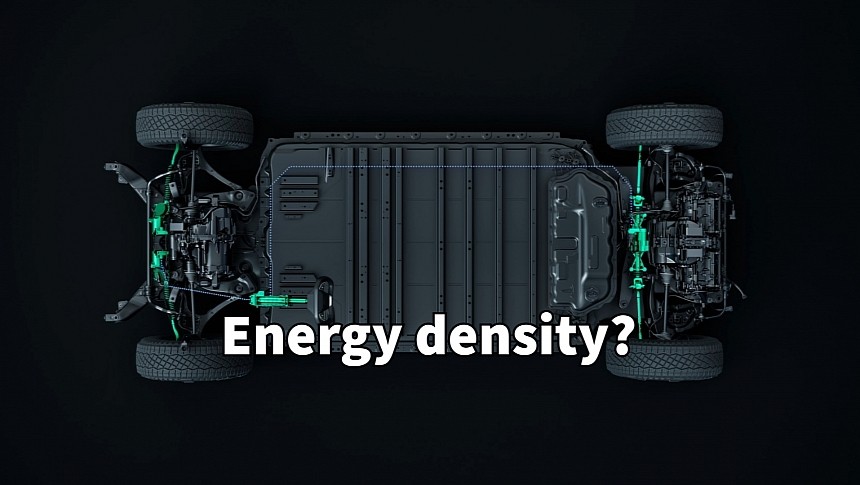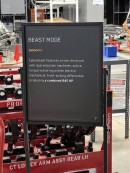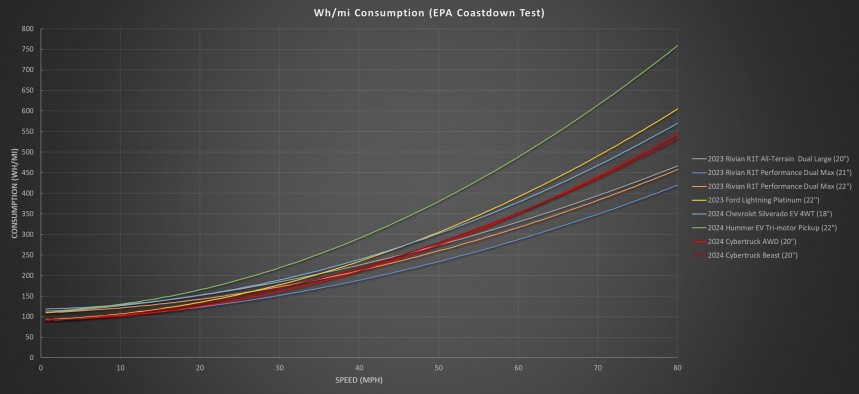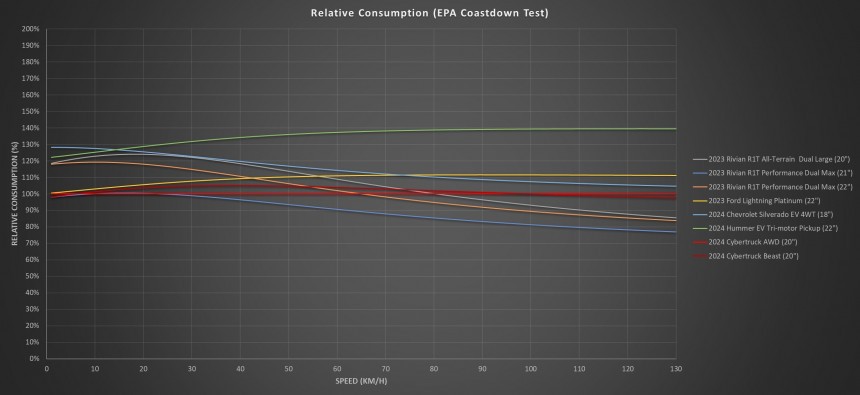The Environmental Protection Agency (EPA) has listed the documents that Tesla filed to certify the Cybertruck. Unfortunately, the range data is unavailable, but the documents are still full of exciting details, such as the Cybertruck's configurations and battery capacity.
Tesla did a lousy job revealing the Cybertruck's technical details, and the few specifications it made public after November 30 were far from making people happy. Most notably, the official range data Tesla presented during the event was a mixed bag.
We'll skip the RWD variant, which is said to arrive in 2025 (if ever) and move to the AWD trim, which has a dual-motor configuration. The 340-mile range is a marked improvement over the 300 miles announced in 2019 during the initial launch. However, the tri-motor Cybertruck, now known as the Cyberbeast, only has 320 miles instead of the advertised 500 miles of range.
Tesla tried to sweeten the pill by announcing a battery range extender that could theoretically push the range of the AWD variant to 470 miles. This is close to the claimed 500 miles but takes away a significant space in the truck's bed. In the meantime, the Cyberbeast only goes 440 miles on a charge, even with the range extender.
Still, this is preliminary data, and everyone was waiting for the official EPA numbers to confirm or infirm this information. This can be closer than expected, as the EPA has already published Tesla's submitted documents as part of the certification process. For now, the range is not revealed in these documents, so we'll have to wait a little longer. However, they are a goldmine for those not satisfied with the technical details Tesla provided.
The EPA documents reveal a few secrets about the Cybertruck, although they are also confusing in some areas. For instance, Tesla announced that the Cyberbeast features two induction motors on the rear axle, whereas the EPA documents state that the Cybertruck features permanent-magnet motors throughout. The AWD Cybertruck has an induction motor in front and a permanent magnet motor on the rear axle. It's hard to say whether the error was in the Tesla presentation (and the posters scattered throughout the Cybertruck production line at Giga Texas) or in the EPA documents.
Based on the latter, the AWD variant features a 303-horsepower motor up front and a 297-hp unit at the rear, for a total of 600 horsepower. The Cyberbeast's front motor delivers 276 horsepower, while the two rear motors each have 284 horsepower, for a total of 845 horsepower. The EPA documents also confirm previous rumors about the 123-kWh energy capacity, thanks to the 800-ish volts (battery voltage varies with the state of charge; EPA docs state 816 volts) and 150 Ah capacity.
This information confirms that the 4680 cells have lower energy density than the 2170 cells, at 170 Wh/kg at the pack level. For reference, the Model Y's pack using 2170 cells has a 180-Wh/kg energy density. The Cybertruck's pack is a structural part, so it's essential to know how much of the battery pack weight is used for structural purposes. This can also affect energy density at the pack level.
The EPA documents also reveal that the Cybertruck will come standard with a heat pump. Not that we expected otherwise, considering that all Tesla EVs are fitted with a heat pump these days. The heat pump uses less energy to cool and heat, and it's essential in colder climates for range-conscious owners. An electric cabin heater can consume more than 25% of the battery in cold weather, whereas a heat pump needs five times less energy for the same result.
The documents also reveal the curb weight of the Cybertruck, with the AWD version at 6,669 pounds (3,025 kg) and the Cyberbeast at 6,898 pounds (3,129 kg). The gross vehicle weight rating (GVWR) is 9,169 pounds for both variants, translating into 2,500 lbs. of payload capacity for the AWD and 2,271 lbs. for the Cyberbeast. Again, we're unsure whether this is another error in the documentation since Tesla listed both trucks with 2,500 lbs. of payload.
If you've been following thus far, you've noticed that two critical things are missing from these certification filings. First, the RWD version of the Cybertruck is missing entirely. That's because Tesla doesn't intend to offer this earlier than 2025. It might not even consider it, though. After all, no electric pickup truck on the market is single-motor for now, although Chevrolet hasn't ruled out the possibility of offering such a variant in the future.
The second part missing is the battery range extender that Tesla announced during the Delivery Day event. This shows that this range extender might not come soon (or at all), which explains the lack of information. Although Tesla fans swear that this was the greatest idea ever, truck owners are not happy to give up three-fifths of their truck bed for a range extender.
How this is connected to the main battery pack and the cooling lines is also unknown. These things dictate whether the range extender is easily removable or more of a permanent solution. My guess is that Tesla expects the 4680 cell performance to increase in the future to the point that a range extender would not be needed.
We'll skip the RWD variant, which is said to arrive in 2025 (if ever) and move to the AWD trim, which has a dual-motor configuration. The 340-mile range is a marked improvement over the 300 miles announced in 2019 during the initial launch. However, the tri-motor Cybertruck, now known as the Cyberbeast, only has 320 miles instead of the advertised 500 miles of range.
Tesla tried to sweeten the pill by announcing a battery range extender that could theoretically push the range of the AWD variant to 470 miles. This is close to the claimed 500 miles but takes away a significant space in the truck's bed. In the meantime, the Cyberbeast only goes 440 miles on a charge, even with the range extender.
Still, this is preliminary data, and everyone was waiting for the official EPA numbers to confirm or infirm this information. This can be closer than expected, as the EPA has already published Tesla's submitted documents as part of the certification process. For now, the range is not revealed in these documents, so we'll have to wait a little longer. However, they are a goldmine for those not satisfied with the technical details Tesla provided.
Based on the latter, the AWD variant features a 303-horsepower motor up front and a 297-hp unit at the rear, for a total of 600 horsepower. The Cyberbeast's front motor delivers 276 horsepower, while the two rear motors each have 284 horsepower, for a total of 845 horsepower. The EPA documents also confirm previous rumors about the 123-kWh energy capacity, thanks to the 800-ish volts (battery voltage varies with the state of charge; EPA docs state 816 volts) and 150 Ah capacity.
This information confirms that the 4680 cells have lower energy density than the 2170 cells, at 170 Wh/kg at the pack level. For reference, the Model Y's pack using 2170 cells has a 180-Wh/kg energy density. The Cybertruck's pack is a structural part, so it's essential to know how much of the battery pack weight is used for structural purposes. This can also affect energy density at the pack level.
The EPA documents also reveal that the Cybertruck will come standard with a heat pump. Not that we expected otherwise, considering that all Tesla EVs are fitted with a heat pump these days. The heat pump uses less energy to cool and heat, and it's essential in colder climates for range-conscious owners. An electric cabin heater can consume more than 25% of the battery in cold weather, whereas a heat pump needs five times less energy for the same result.
If you've been following thus far, you've noticed that two critical things are missing from these certification filings. First, the RWD version of the Cybertruck is missing entirely. That's because Tesla doesn't intend to offer this earlier than 2025. It might not even consider it, though. After all, no electric pickup truck on the market is single-motor for now, although Chevrolet hasn't ruled out the possibility of offering such a variant in the future.
The second part missing is the battery range extender that Tesla announced during the Delivery Day event. This shows that this range extender might not come soon (or at all), which explains the lack of information. Although Tesla fans swear that this was the greatest idea ever, truck owners are not happy to give up three-fifths of their truck bed for a range extender.
How this is connected to the main battery pack and the cooling lines is also unknown. These things dictate whether the range extender is easily removable or more of a permanent solution. My guess is that Tesla expects the 4680 cell performance to increase in the future to the point that a range extender would not be needed.





















